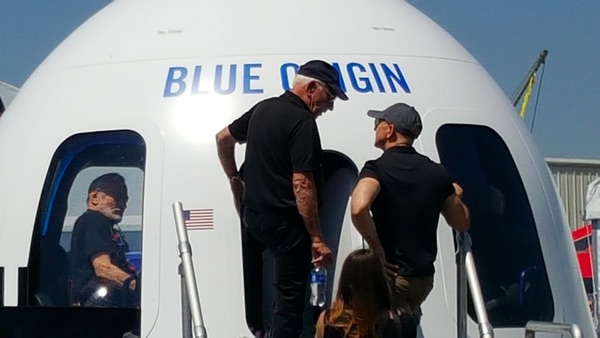Blue Origin meets Apolloby Eric R. Hedman
|
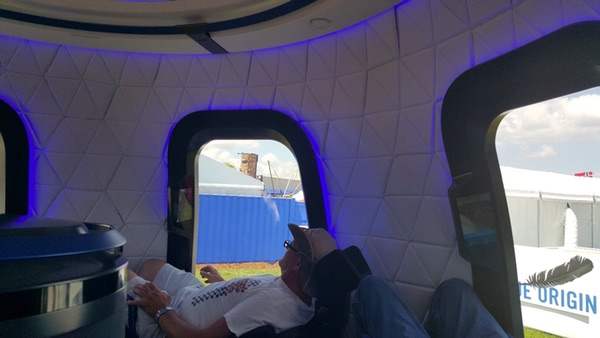 The interior of the New Shepard capsule. (credit: E. Hedman) |
Next to the booster was a capsule that space tourists and scientists will fly inside on suborbital trajectories, experiencing roughly four minutes of weightlessness. The capsule has six seats reclined next to six very large windows with what will surely be an outstanding view of Earth and space. In addition to the seats and windows, there is a small video screen next to each window clearly in the view of each passenger, providing views during the flight of things not easily seen even out of the large windows, such as the parachute deployment. There is a handle that rings the roof of the capsule (visible in the top left of the photo) and another that is at the top edge of a cylindrical console in the center of the capsule (visible in the lower left of the photo) designed for passengers to grab onto to move around while in microgravity. (See also “Blue Origin’s status update”, The Space Review, April 10, 2017.)
| In a sea of aircraft of all types, a sixty-foot-tall rocket stands out. |
I learned that I’m probably a bit too tall to take a flight on this vehicle. When I tried out one of the seats, the side supports on the headrest were pressing right in the middle of my shoulder blades. Our guide told me that I’d probably need a custom seat if I were to take a flight. It isn’t too likely that I’d be taking flight in one of these, so I wasn’t that disappointed or surprised. Several years ago, I tried to see if I could fit in the cockpit of an F-18 and discovered I would have to bend my head forward so the canopy could close so I wasn’t expecting this capsule to be designed for someone my size. Most people won’t have this problem.
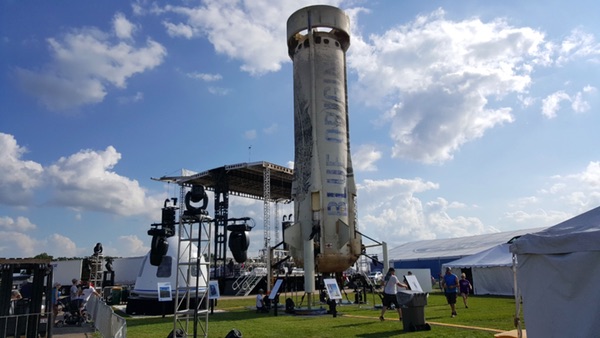 The New Shepard propulsion module, showing the wear and tear of five suborbital spaceflights. (credit: E. Hedman) |
The New Shepard rocket on display has flown five times. As you can see from the photo above it doesn’t look like it’s right out of the factory paint shop. Obviously, the thermal environment of the flight has its effect on the coating that insulates the vehicle. I asked one of the Blue Origin employees about how the coating holds up. I was told it was easy enough to recoat the vehicle between flights. I did not ask if that must be done between every flight.
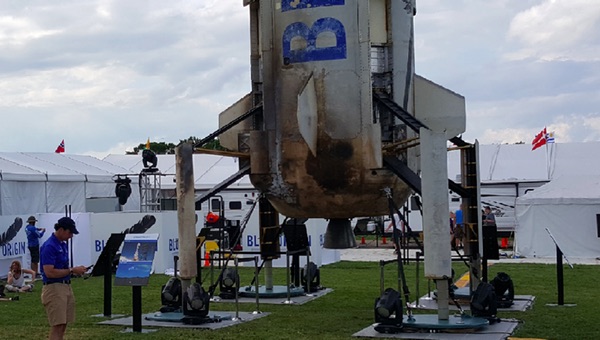 A closeup of the New Shepard propulsion module. (credit: E. Hedman) |
Part of selling anything begins with the optics. You have to wonder if the recoating frequency will be dictated by thermal protection needs or the need to make the vehicle look less like it has been singed by a blowtorch. Human psychology about facing risk could be an interesting part of that decision. Do the burn marks make it look like a tough rugged vehicle? Do the burn marks scare potential passengers reminding them that this won’t be a typical weekend joyride? Will passengers be expecting a shiny new vehicle that looks like I just rolled out of the factory? I honestly don’t know which more people will find appealing.
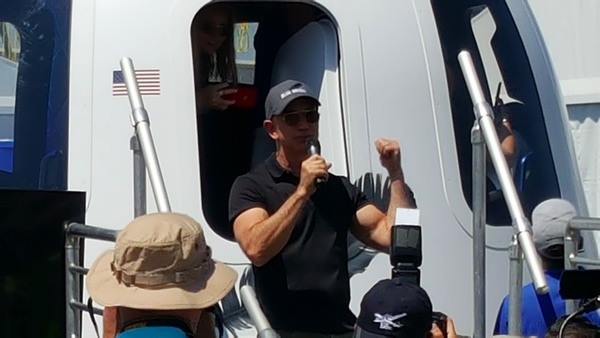 Jeff Bezos is pumped up to talk about New Shepard. (credit: E. Hedman) |
In an interview with Charlie Rose in 2016 Jeff Bezos said that Blue Origin had more than 800 employees. Also in the interview Jeff Bezos said that the goal of his company was to reduce the cost of launching payloads into space by two orders of magnitude to enable the next generation of entrepreneurs who will move industries into space.
| It is fitting Blue Origin and Jeff Bezos were at the EAA. I can imagine the pride Bezos must have felt in showing his rocket to the Apollo astronauts. |
Another comment in the Charlie Rose interview that illustrates Jeff Bezos’ mindset in running his businesses was his goal for the Washington Post. He wants to change the business model from a small number of readers of a local newspaper who pay high prices into a national or international paper with many readers who pay a low price. He went on to say that distribution through the Internet is what makes that possible. High volume and low prices is the model he has for Amazon. If he can reduce the cost of launch, the same business model also applies to Blue Origin. In the interview, he said that a vehicle has to be designed from the beginning to not need massive refurbishment between flights to bring the cost down.
Some people think that Jeff Bezos can continue to pour large amounts of money into Blue Origin. He can, but he’s a successful businessman and he wants to make money from Blue Origin. He doesn’t want it to be just a hobby business. He believes heavy industries should be in space where resources and energy are. Don’t expect Blue Origin to mine the Moon and asteroids or to build habitats or to manufacture products in space. He wants to make money moving payloads from point A to point B affordably to enable other companies to succeed in expanding into the cosmos.
It is fitting Blue Origin and Jeff Bezos were at the EAA. It was fitting that he was able to show his work to the Apollo astronauts. Apollo is what inspired not only him, but also many engineers, to pursue STEM careers. Many didn’t end up working in space, but have helped advance many technologies that have advanced our society. I can imagine the pride Bezos must have felt in showing his rocket to the Apollo astronauts.
When Blue Origin met the Apollo astronauts in Oshkosh it felt like the torch was being passed willingly to the next generation. If Jeff Bezos succeeds in his vision of providing the affordable transportation to support the next generation of space entrepreneurs he will continue the cycle and eventually pass on the torch that was handed to him and to others on that beautiful day in Oshkosh. What that following generation could do with it is one key reason why the current generation works so hard and ingeniously to build upon the foundation previous generations built for us. I am more optimistic about our future in space than I have been in a long time. I see the pieces starting to fall into place. I was lucky to be there the day Blue Origin met Apollo.
